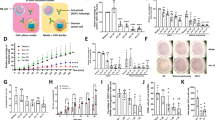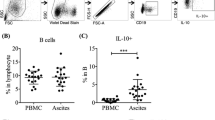Summary
The effect of cell-free ascitic fluid from patients with epithelial ovarian carcinoma on the generation of lymphokine-activated killer cells (LAK) was compared to the activity generated in control medium containing 10% fetal bovine serum, using Daudi target cells. Samples of ascitic fluid from nine different patients tested inhibited LAK generation. Suppressive activity was evident as early as 24 h of incubation in the presence of ascitic fluid and increasing suppression developed with prolonged exposure. Suppression was concentration-dependent, present at 10%–20% and increasing with concentrations up to 80%. The suppressive effect of ascitic fluid was only partially reversed on increasing the concentration of interleukin-2 (IL-2) from 10 units to 1000 units/ml. Activated LAK appeared to maintain the majority of their activity on further culture in ascitic fluid in the presence of IL-2 but further enhancement of lytic activity was prevented. Fractionation of a suppressive sample by HPLC, using 0.1 M KCl/acetic acid buffer pH 2.6, revealed that the dominant peak of suppressive activity eluted at 25 kDa; with pH 7.0 TRIS-buffered saline, most of the activity was lost on the column. Antibody neutralization studies of the 25-kDa suppressive peak as well as on whole ascitic fluid have revealed that transforming growth factor β (TGFβ) is the major suppressive factor present in ascitic fluid. Factors that suppress LAK generation in vitro were present in all samples tested. The effect on the lytic activity of activated LAK cells was minimal. This suggests that, in the clinical setting, the greatest impact would be achieved by activating LAK cells ex vivo and subsequently transferring them to the peritoneal cavity in the presence of IL-2 rather than by attempting to generate them in situ by injecting IL-2 into the peritoneal cavity. However, reversal of TGFβ-mediated suppression in situ may be necessary to allow local proliferation of LAK cells to achieve an effective killer-totarget ratio.
Similar content being viewed by others
References
Anzano MA, Roberts AB, Smith JM, Sporn MB, DeLaco JE (1983) Sarcoma growth factor from conditioned medium of virally transformed cells is composed of both type a and type b transforming growth factors. Proc Natl Acad Sci USA 80: 6264
Anzano MA, Roberts AB, DeLaco JE, Wakefield LM, Assoian RK, Roche NS, Smith JM, Lazarus JE, Sporn MB (1985) Increased secretion of type beta transforming growth factor accompanies viral transformation of cells. Mol Cell Biol 5: 242
Badger AM, Oh SK, Moolten FR (1981) Differential effects of an immunosuppressive fraction from ascites fluid of patients with ovarian cancer on spontaneous and antibody-dependent cytotoxicity. Cancer Res 41: 1133
Cianciolo GJ, Copeland TD, Oroszlan S, Snyderman R (1985) Inhibition of lymphocyte proliferation by a synthetic peptide homologous to retroviral envelope proteins. Science 230: 453
Cianciolo GJ, Snyderman R (1986) Effects of tumor growth on host defenses. Cancer Metastasis Rev 5: 15
Clark J, Longo DL (1989) Lymphokine-activated killer lymphocytes: National Cancer Institute clinical trials. Adoptive cellular immunotherapy of cancer. Dekker, New York, p 37
Clark DA, Phillips RA, Miller RG (1977) Characterization of the cells that suppress the cytotoxic activity of T lymphocytes: II. Physical properties, specificity, and developmental kinetics of the inhibitory splenic non-T cell population. Cell Immunol 34: 25
Djeu JY, Kavanagh JJ, Sinkovics JG, Cavanagh D, Blanchard DK (1989) Activation of killer cells by interleukin-2 in ascitic fluid and pleural effusions of advanced cancer patients. Proc Assoc Cancer 30: 369
Fumita Y, Tanaka F, Saji F, Nakamuro K (1984) Immunosuppressive factors in ascites fluids from ovarian cancer patients. Am J Reprod Immunol Microbiol 6: 175
Grimm EA, Mazumder A, Zhang HZ, Rosenberg SA (1982) Lymphokine-activated killer cell phenomenon: lysis of natural killer-resistant fresh solid tumor cells by interleukin 2-activated autologous human peripheral blood lymphocytes. J Exp Med 155: 1823
Grimm EA, Crump WL, Durett A, Hester JP, Lagoo-Deenadalayan S, Owen-Schaub LB (1988) TGF-beta inhibits the in vitro induction of lymphokine-activated killing activity. Cancer Immunol Immunother 27: 53
Guillou PJ, Sedman PC, Ramsden CW (1989) Inhibition of lymphokine-activated killer cell generation by cultured tumor cell lines in vitro. Cancer Immunol Immunother 28: 43
Harris DT, Cianciolo GJ, Snyderman R, Argov S, Koren HS (1987) Inhibition of human natural killer cell activity by a synthetic peptide homologous to a conserved region in the retroviral protein p15E. J Immunol 138: 889
Hess AD, Gall SA, Dawson JR (1979) Inhibition of in vitro lymphocyte function by cystic and ascitic fluids from ovarian cancer patients. Cancer Res 39: 2381
Hess AD, Gall SA, Dawson JR (1980) Partial purification and characterization of a lymphocyte-inhibitory factors(s) in ascitic fluids from ovarian cancer patients. Cancer Res 40: 1842
Ibayashi Y, Hoon DSB, Golub SH (1987) The regulatory effect of adherent cells on lymphokine activated killer cells. Cell Immunol 110: 365
Itoh K, Pellis NR, Balch CM (1989) Monocyte-dependent, serumborne suppressor of induction of lymphokine-activated killer cells in lymphocytes from melanoma patients. Cancer Immunol Immunother 29: 57
Lafreniere R, Rosenberg SA (1985) Successful immunotherapy of murine experimental hepatic metastases with lymphokine-activated killer cells and recombinant interleukin 2. Cancer Res 45: 3735
Leung KH (1989) Inhibition of human NK cell and LAK cell cytotoxicity and differentiation by PGE2. Cell Immunol 123: 384
Lichtenstein AK, Berek J, Zighelboim J (1985) Natural killer inhibitory substance produced by the peritoneal cells of patients with ovarian cancer. J Natl Cancer Inst 74: 349
Loeffler D, Heppner G (1989) Influence of tumor microenvironmental factors on NK and LAK cells. Proc Am Assoc Cancer Res 30: 365
Lotze MT, Grimm EA, Mazumder A, Strausser JL, Rosenberg SA (1981) Lysis of fresh and cultured autologous tumor by human lymphocytes cultured in T-cell growth factor. Cancer Res 41: 4420
Mazumder A, Rosenberg SA (1984) Successful immunotherapy of natural killer-resistant established pulmonary melanoma metastases by the intravenous adoptive transfer of syngeneic lymphocytes activated in vitro by interleukin 2. J Exp Med 159: 495
Mule JJ, Schwarz SL, Roberts AB, Sporn MB, Rosenberg SA (1988) Transforming growth factor-beta inhibits the in vitro generation of lymphokine-activated killer cells and cytotoxic T cells. Cancer Immunol Immunother 26: 95
Oh SK, Moolten FL (1981) Purification and characterization of an immunosuppressive factor from ovarian cancer ascites fluid. Eur J Immunol 11: 780
Owen-Schaub LB, Grimm EA (1989) Lymphokine-activated killer lymphocytes: evidence for regulation of induction and function by multiple cytokines. Adoptive cellular immunotherapy of cancer. Dekker, New York, p 19
Owen-Schaub LB, Gutterman JU, Grimm EA (1988) Synergy of tumor necrosis factor and interleukin 2 in the activation of human cytotoxic lymphocytes: effect of tumor necrosis factor-alpha and interleukin 2 in the generation of human lymphokine-activated killer cell cytotoxicity. Cancer Res 48: 788
Pross HF, Baines MG, Rubin P, Shragge P, Patterson MS (1981) Spontaneous human lymphocyte-mediated cytotoxicity against tumor target cells: IX. The quantitation of natural killer cell activity. J Clin Immunol 1: 51
Ramsdell FJ, Shau H, Golub SH (1988) Role of proliferation in LAK cell development. Cancer Immunol Immunother 26: 139
Ratner S, Heppner GH (1988) Motility and tumoricidal activity of interleukin-2-stimulated lymphocytes. Cancer Res 48: 3374
Riley LB, Pellis NR, Itoh SP (1989) Cancer patients have two distinct inhibitors of LAK induction. Proc Am Assoc Cancer Res 30: 366
Rosenberg SA, Lotze MT, Muul LM, Leitman S, Chang AE, Ettinghausen SE, Matory YL, Skibber JM, Shiloni E, Vetto JT, Seipp CA, Simpson C, Reichert CM (1985) Observations on the systemic administration of autologous lymphokine-activated killer cells and recombinant interleukin 2 to patients with metastatic cancer. N Engl J Med 313: 1485
Rosenberg SA, Lotze MT, Muul LM, Chang AE, Avis FP, Leitman S, Linehan WM, Robertson CN, Lee RE, Rubin JT, Seipp CA, Simpson CG, White MS (1987) A progress report on the treatment of 157 patients with advanced cancer using lymphokine-activated killer cells and interleukin 2 or high dose interleukin 2 alone. N Engl J Med 316: 889
Sawada M, Okudaira Y, Matsui Y, Shimizu Y (1983) Immunosuppressive acidic protein in patients with ovarian cancer. Cancer 52: 2081
Shau H, Kim A (1988) Suppression of lymphokine-activated killer induction by neutrophils. J Immunol 141: 4395
Sone S, Yanagawa H, Nii A (1989) Lymphokine (IL-2)-activated killer (LAK) induction and its regulation in malignant pleural effusion of lung cancer patients. Proc Am Assoc Cancer Res 30: 373
Steis R, Bookman M, Clark J (1987) Intra-peritoneal lymphokine activated killer (LAK) cell and interleukin-2 (IL-2) therapy for peritoneal carcinomatosis: toxicity, efficacy, and laboratory results. Proc Soc Clin Oncol 6: 250
Stewart J, Belinson J, Grant B (1988) Phase I evaluation of intraperitoneal (IP) interleukin-2 (IL-2) and lymphokine activated killer cells (LAK) in patients with ovarian cancer. Proc Am Soc Clin Oncol 7: 162
Tamura K, Shibata Y, Matsuda Y, Ishida N (1981) Isolation and characterization of an immunosuppressive acidic protein from ascitic fluids of cancer patients. Cancer Res 41: 3244
Taylor DD, Taylor CG, Pelton JJ, Weese JL (1989) Tumor modulation of rIL-2-activated killer (LAK) cells. Abstracts of the Society for Biological Therapy Annual Meeting, Williamsburg, Va., Nov 16–19; p 15
Wrann M, Bodmer S, de Martin R (1987) T cell suppressor factor from human glioblastoma cells is a 12.5 kd protein closely related to transforming growth factor-beta. EMBO J 6: 1633
Xiao J, Brahmi Z (1989) Target cell-directed inactivation and IL-2-dependent reactivation of LAK cells. Cell Immunol 122: 295
Author information
Authors and Affiliations
Additional information
Supported by a grant from the National Cancer Institute of Canada D.A.C. is a recipient of a Scientist Award from the Medical Research Council (Canada)
Rights and permissions
About this article
Cite this article
Hirte, H., Clark, D.A. Generation of lymphokine-activated killer cells in human ovarian carcinoma ascitic fluid: Identification of transforming growth factor-β as a suppressive factor. Cancer Immunol Immunother 32, 296–302 (1991). https://doi.org/10.1007/BF01789047
Received:
Accepted:
Issue Date:
DOI: https://doi.org/10.1007/BF01789047




